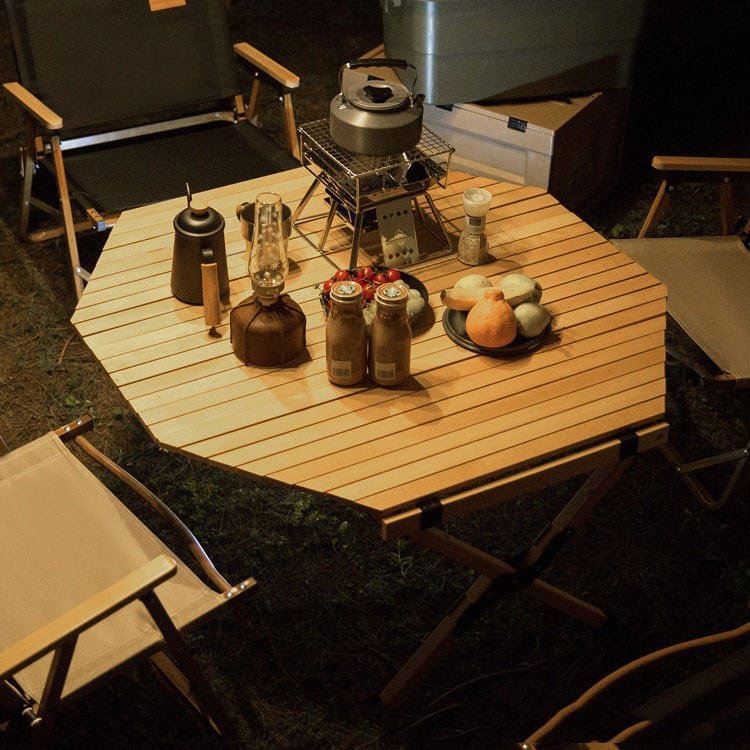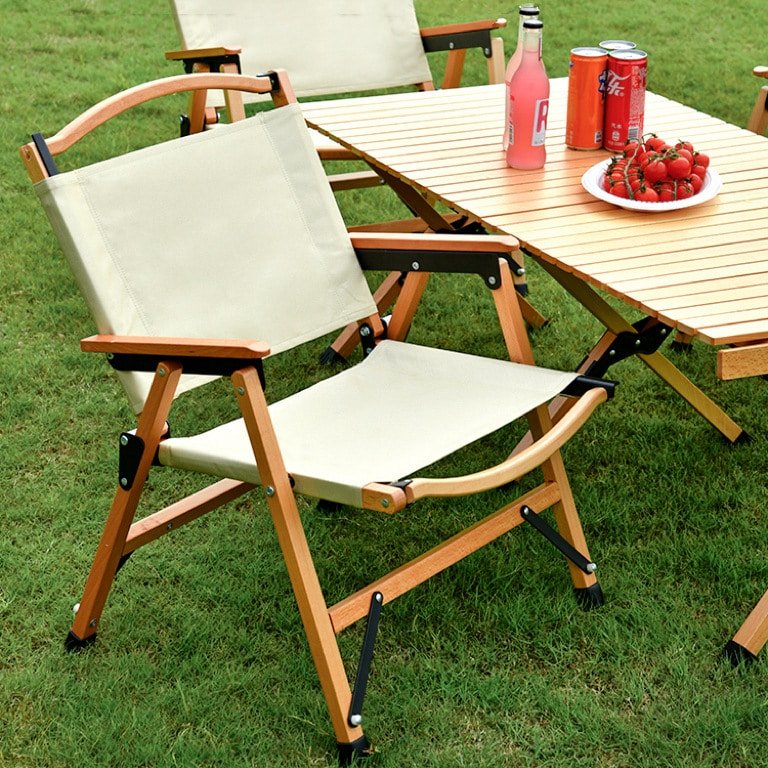Today, when courtyards, balconies and gardens are increasingly becoming important living spaces, outdoor wooden furniture has become the core element to improve the quality of outdoor living with its unique natural texture, warm touch and harmonious integration with the environment. However, the harsh outdoor environment puts high demands on wood. This article will in-depth discussion on the material selection, key processes, design points and maintenance of outdoor wooden furniture, and provide professional references for professionals and consumers.
- Core materials: choose the right wood to lay the foundation
The success or failure of outdoor furniture begins with wood selection. Focus on the three core properties of corrosion resistance, stability and durability:
Classic Hardwood:
Teak: “The King of Outdoors”. It contains high amounts of oil and silicon, and has excellent corrosion resistance, insect resistance and deformation resistance, and has extremely strong weather resistance. Over time, the color gradually changes from golden to elegant silver gray. The price is high and it is a top choice.
Balao wood/Engine wood: High density, high hardness, strong oiliness, high natural corrosion resistance (Class 1), good weather resistance, stable structure, and reddish-brown color. It has high cost performance and is widely used.
Other high-quality hardwoods: such as African rosewood (Sabil), golden pomelo, etc., with good performance and specific analysis of origin and grade.
Deep treatment of wood:
Anticorrosive wood (such as ACQ, CCA treated pine): By injecting preservatives (copperzole ACQ or environmentally friendly alternatives) at high pressure, the anticorrosion and insect resistance capabilities of ordinary wood (such as Southern Pine and Largo) are greatly improved (can reach Class 3 or above), and the cost is relatively low. It is necessary to ensure that the preservative meets environmental standards (such as ACQ), and pay attention to the color difference after treatment and possible metal precipitation.
Carbonized wood (thermal modified wood): Treat wood at high temperatures (usually 180-230°C) in an oxygen-deficient environment. High temperature degrades and reorganizes the wood hemicellulose, significantly improving dimensional stability, moisture resistance and corrosion resistance (up to Class 2-3), and has a uniform color and dark brown. Low resin, not easy to crack, good environmental protection (no chemical addition). The intensity decreased slightly.
Sustainable Alternative Materials:
Wood-plastic composite material: It is mixed with wood fiber/wood powder and plastic (such as PE, PP) and additives. Almost maintenance-free, anti-corrosion and insect resistance, not afraid of moisture, rich in color and long service life. The texture and touch are different from solid wood. Long-term exposure to the sun may fade slightly, so you need to pay attention to the quality of the raw materials and structural strength design.

- Key technology: meticulous work to ensure durability
High-quality materials need to be combined with exquisite craftsmanship to achieve durable outdoor furniture:
Fine drying treatment: Strictly controlling the moisture content of wood (usually need to be reduced to below 12%) is the key first step to prevent later cracking and deformation.
Scientific anti-corrosion treatment (if applicable): Anti-corrosion wood must ensure that the injection depth of the agent and the amount of the drug is maintained to meet the standards (such as ACQ ≥ 6.5kg/m³), and the treatment process is uniform and thorough.
Structural design:
Drainage design: Reasonable drainage inclination and gaps (about 3-5mm) should be designed to avoid water accumulation.
Connection process: Priority is given to mortise and tenon structures, stainless steel/galvanized anti-corrosion metal connecting parts (screws, bolts). Avoid ordinary iron parts (prone to rust). The glue must be waterproof and weather-resistant glue (such as epoxy resin, polyurethane glue) for users.
Stress release: Reserve expansion joints to allow wood to naturally expand and shrink with changes in humidity.
Surface treatment:
Fine polishing: All surfaces, especially those in contact with the human body, must be highly polished and smooth to prevent wood thorns.
Professional coating: Use high-quality outdoor wood paint/wood oil (permeable or film-forming):
Permeable wood oil/wood wax oil: Deeply nourish the wood, maintaining natural texture and breathability, and has a good touch. Need to be maintained regularly (usually 1-2 years). The weather resistance is slightly weaker than the film forming type.
Film-forming outdoor paint: Form protective films on the surface of the wood (such as high-quality water-based/oil-based acrylic polyurethane paint) to provide stronger UV resistance, stain-proof, wear-resistant and waterproof protection. Good durability (3-5 years or longer), matte, semi-matte, and bright effects are available.
Key points: Ensure that the coating is uniform and fully covered, especially the ends and ends need to be treated with the “capillaries” of the wood). Multi-layer coating is better.
- Design points: Integrating aesthetics and functions
Outdoor furniture design needs to balance visual beauty with practical comfort:
Ergonomics: The seat height, depth, backrest angle, and handrail height must conform to the comfortable sitting posture of the human body.
Lightweight and stability: Considering outdoor mobile needs, optimize weight while ensuring a strong structure (wind resistance and load bearing). A wide base or increased weight design helps to stabilize.
Modularity and Combination: Adapt to different space and scenario needs and increase flexibility.
Natural style orientation: The design lines are usually simpler, smoother or rough, emphasizing the texture and color of the wood itself, in harmony with the natural environment. Avoid excessively complex carvings.
Easy to maintain: The structural design should be easy to clean (reduce blind spots) and facilitate post-paint repair maintenance.

- Maintenance: The art of extending life
Regular maintenance is the key to maintaining the beauty and life of outdoor wooden furniture:
Daily cleaning: Use a soft brush or vacuum cleaner to remove dust and leaves regularly. Wipe the stains with clean water or neutral detergent (diluted) and soft cloth and dry them in time. Avoid strong acid and alkali cleaners.
Regular inspection and maintenance:
Coating maintenance: When the surface of the wood appears dry, gray, and water absorption, maintenance is required. After cleaning and drying, re-apply 1-2 times of outdoor wood oil or wood paint of the same type. Slight polishing before repainting is better.
Check the connectors: Check and tighten loose screws and bolts regularly.
Treatment of mold spots: Mild mildew spots can be treated with special wood mold removal agent or diluted bleach (used with caution), thoroughly clean and dry, and re-oil/paint.
Seasonal protection (optional): In severe cold, snowy or long-term exposure to the sun, consider using a special protective cover or move it to a semi-shaded place to store. Avoid long-term soaking or direct contact with wet soil.
Respect natural variation: Allowing hardwood (especially teak) to naturally weather to form a uniform silver grey color, which is its unique charm.
Outdoor wooden furniture carries a beautiful vision of integrating natural comfort into life. Only by understanding the natural characteristics of different woods, paying attention to deep treatment technology and scientific structural design, choosing appropriate surface protection solutions, and supplementing them with persistent and meticulous maintenance, can this natural gift last forever in the sun and rain, and continue to inject warm, texture and lasting value into the outdoor space. In today’s increasingly important environment and sustainable development, choosing legal, certified sustainable wood (such as FSC/PEFC certification) or high-quality recycled wood/composite materials is also a responsible choice for professionals and consumers.

